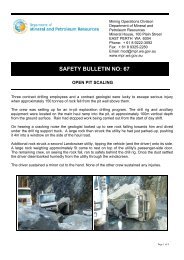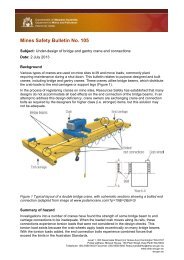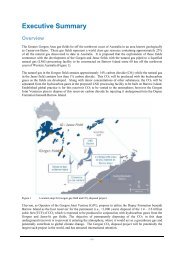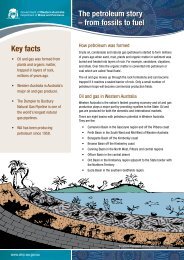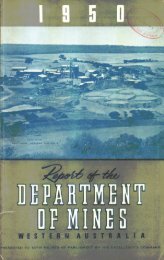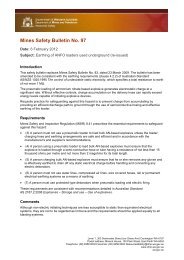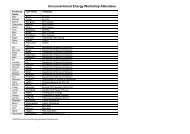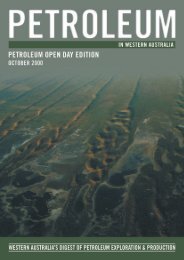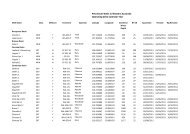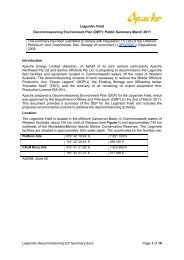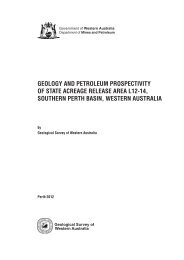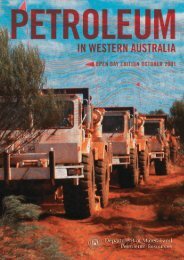Geothermal Energy Potential in Selected Areas of Western Australia ...
Geothermal Energy Potential in Selected Areas of Western Australia ...
Geothermal Energy Potential in Selected Areas of Western Australia ...
You also want an ePaper? Increase the reach of your titles
YUMPU automatically turns print PDFs into web optimized ePapers that Google loves.
11<br />
basement contour maps presented by Iasky (1994) 6 . All available data suggest that<br />
Palaeozoic basement reaches a maximum depth <strong>of</strong> >13 km <strong>in</strong> the Perth Bas<strong>in</strong>.<br />
3.2. Basement Lithology<br />
The basement underly<strong>in</strong>g the Perth Bas<strong>in</strong> is comprised primarily <strong>of</strong> Proterozoic<br />
granulites, gneisses, metasediments and granite <strong>in</strong>trusions <strong>of</strong> the P<strong>in</strong>jarra Orogen.<br />
Basement outcrops can be seen <strong>in</strong> fault bounded mid-bas<strong>in</strong> ridges <strong>in</strong> the<br />
Northampton Complex at the northern end <strong>of</strong> the Perth Bas<strong>in</strong>, and <strong>in</strong> the Leeuw<strong>in</strong><br />
Complex on the western marg<strong>in</strong> <strong>of</strong> the Bunbury Trough.<br />
Basement lithologies were estimated for the Perth Bas<strong>in</strong> based on the known<br />
basement lithology <strong>of</strong> nearby wells, and the cont<strong>in</strong>uation <strong>of</strong> geophysical signatures<br />
(gravity and magnetics) from areas <strong>of</strong> known basement compositions. For some<br />
wells, especially those <strong>in</strong> areas <strong>of</strong> very deep sedimentary sections (>10 km), a<br />
determ<strong>in</strong>ation was not made due to the lack <strong>of</strong> <strong>in</strong>formation available to allow for a<br />
reasonable level <strong>of</strong> certa<strong>in</strong>ty <strong>in</strong> determ<strong>in</strong><strong>in</strong>g the lithologies. For all other wells <strong>in</strong> this<br />
study, however, basement lithology was estimated. Attachment C details <strong>in</strong>dividual<br />
lithology estimates for the 170 wells not previously studied, and Attachment D for the<br />
80 previously studied wells.<br />
While HDRPL has drawn on all available <strong>in</strong>formation, the exact nature <strong>of</strong> the<br />
basement <strong>of</strong> the Perth Bas<strong>in</strong> rema<strong>in</strong>s poorly constra<strong>in</strong>ed. Gravity data are <strong>of</strong> limited<br />
use for lithology determ<strong>in</strong>ation <strong>in</strong> much <strong>of</strong> the Perth Bas<strong>in</strong> ow<strong>in</strong>g to the great<br />
thickness <strong>of</strong> the post-Permian succession. Lithology estimates for basement were<br />
guided by basement lithologies <strong>in</strong>tersected <strong>in</strong> wells, and the assumption that a similar<br />
lithology may be expected with<strong>in</strong> a 10 km radius—the approximate size <strong>of</strong> a small<br />
pluton. Wells outside these areas are denoted as hav<strong>in</strong>g an “unknown” basement<br />
lithology, although it is probable that many <strong>of</strong> these “unknown” lithologies are pre-rift<br />
metasediments.<br />
6 Iasky R.P. 1994, Onshore northern Perth Bas<strong>in</strong> gravity project. In Geological Survey <strong>of</strong> <strong>Western</strong> <strong>Australia</strong>,<br />
1993-1994 Annual Review<br />
www.hotdryrocks.com




